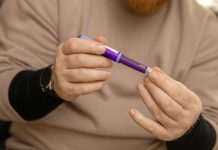
Diabetic retinopathy is an eye condition that can cause vision loss and blindness in people who have diabetes.
It affects blood vessels in the retina (the light-sensitive layer of tissue in the back of your eye).
If you have diabetes, it’s important to get a comprehensive dilated eye exam at least once a year. Diabetic retinopathy may not have any symptoms at first — but finding it early can help you take steps to protect your vision.
Managing your diabetes — by staying physically active, eating healthy, and taking your medicine — can also help you prevent or delay vision loss.
Other types of diabetic eye disease
Diabetic retinopathy is the most common cause of vision loss for people with diabetes. But diabetes can also make you more likely to develop several other eye conditions:
Cataracts. Having diabetes makes you 2 to 5 times more likely to develop cataracts. It also makes you more likely to get them at a younger age. Learn more about cataracts.
Open-angle glaucoma. Having diabetes nearly doubles your risk of developing a type of glaucoma called open-angle glaucoma. Learn more about glaucoma.
What are the symptoms of diabetic retinopathy?
The early stages of diabetic retinopathy usually don’t have any symptoms. Some people notice changes in their vision, like trouble reading or seeing faraway objects. These changes may come and go.
In later stages of the disease, blood vessels in the retina start to bleed into the vitreous (gel-like fluid that fills your eye). If this happens, you may see dark, floating spots or streaks that look like cobwebs.
Sometimes, the spots clear up on their own — but it’s important to get treatment right away. Without treatment, the bleeding can happen again, get worse, or cause scarring.
What other problems can diabetic retinopathy cause?
Diabetic retinopathy can lead to other serious eye conditions:
Diabetic macular edema (DME). Over time, about 1 in 15 people with diabetes will develop DME.
DME happens when blood vessels in the retina leak fluid into the macula (a part of the retina needed for sharp, central vision). This causes blurry vision.
Neovascular glaucoma. Diabetic retinopathy can cause abnormal blood vessels to grow out of the retina and block fluid from draining out of the eye. This causes a type of glaucoma (a group of eye diseases that can cause vision loss and blindness).
Retinal detachment. Diabetic retinopathy can cause scars to form in the back of your eye. When the scars pull your retina away from the back of your eye, it’s called tractional retinal detachment.
Sign up for our newsletter for more information about this topic.
If you care about diabetes, please read studies about habit that could reduce diabetes-related high blood pressure, and findings of common fish that may help lower diabetes risk.
For more information about diabetes, please see recent studies about new way to find diabetes-related eye disease early, and results showing eating more whole grain food could strongly reduce type 2 diabetes risk.



